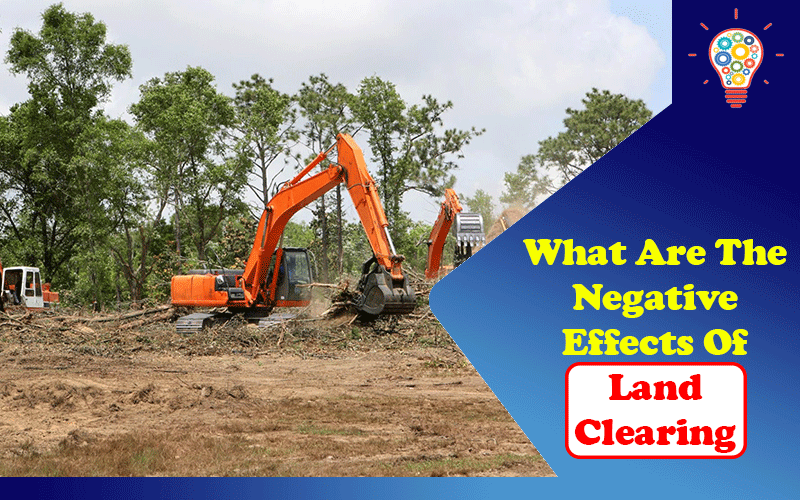Land clearing has many adverse effects on the environment, plants, and animals, and if done to the extreme, it can destroy a whole ecosystem.
Since 1600, about 75% of virgin land has been destroyed across the United States to create room for agricultural activities. In 1998, 12% of Australia’s total gas emissions were from land clearing. This practice directly affects us, and it is worrying that most people do not care about the matter.
This is a challenge affecting multiple states, and therefore, there is the need to educate and empower people on the topic. If we do not take action now, land clearing will disrupt our ecosystem and affect the balance.
Table of Contents
What Are The Main Causes Of Land Clearing?
To come up with solutions to a problem, we need first to understand the causes, and the leading causes of land clearing are:
-
Development projects
A lot of the time this land clearing is not large-scale operations and is paid for by property owners. These are smaller plots of land between 5 and 100 acres that are being cleared by the farmers for running livestock, plant grasses or subdivide and sell for profit and developments.
As the population continues to increase, there is a need to develop more homes. This results in the destruction of vegetation by land clearing.
-
Agricultural Activities
Sadly, many people see natural vegetation as wasted land. People opt to clear this land and use it for agricultural activities. As you prepare the land, you have to clear the foliage, harm animals in the area, and break up the soil.
Sometimes, there is no reason to damage the ecosystem for financial gain.
What are the effects of land clearing?
1. Destruction Of Natural Habitats
This is the immediate effect of land clearing on animals and birds. This act involves the removal of all vegetation that also causes soil disruptions.
All wild animals live in such vegetation, and after the land gets cleared, they have to move to different habitats, disrupting the ecosystem there.
Animals were living in the area before, and by clearing, we destroy their homes, leaving them vulnerable.
2. Species Extension
Australia is home to many species, but the rate of animal extension is growing by the day. One of the factors facilitating this growth rate is land clearing.
Land clearing directly kills and harms animals. The machines and techniques that we use threaten the lives of these animals. There are higher chances that you can eliminate a whole species in the process.
Destroying an animal’s habitat leaves it vulnerable to predators, pests, and diseases that kill it, leading to extinction.
This process primarily affects birds as statistics show that the population of terrestrial birds has gone down by 5% from 1990. The main reason is the destruction of their natural habitats.
Also, land clearing causes the extinction of plant species. When you clear any natural vegetation, there are chances that you could be eliminating plant species.
3. Encourages Soil Erosion
The immediate result after land clearing is you leave the soil exposed to erosion. When agents of erosion, such as wind and heavy rainfall, the soil gets eroded, and the land lacks natural nutrients.
If you were to use the land for agriculture, crop production would be minimal.
Extensive clearing facilitates the occurrence of mudslides in an area.
4. Leads To Land Degradation
Before land clearing, the roots held the topsoil together, preserving the nutrients in the area. Also, other animals added nutrients to the soil. After land clearing, the roots are no longer there to hold the earth, and there are no animals to increase the nutrient levels, resulting in land degradation.
Even after clearing land and using it for agriculture, constant clearing degrades the soil and eventually ends up infertile.
5. Climate Changes
This is not an immediate effect, and it happens after land clearing happens; this means that it also takes time to reverse it.
Areas, where land clearing occurs, show a steady increase in temperature levels. This is mainly because there are no trees to attract rainfall. The result is the area starts experiencing desert conditions.
According to a UN study, 1/3 of all global carbon emissions are caused by land clearing and farming. This percentage steadily grows as years go by, and in the future, it might be extreme if we do not act now.
6. Disrupts The Ground Water Levels
Apart from holding the soil together, the roots keep groundwater levels balanced. Clearing and removing these roots makes the water levels rise, increasing the salt content in the soil. It is hard for plants to grow in this soil, and if you consider doing farming on the land, your production will be minimal.
You will have damaged the ecosystem even more.
Changes in groundwater levels have a direct effect on other water sources.
7. Affects Rivers And Coasts
After land gets exposed and erosion occurs the sediments and nutrients runoff into rivers. High nutrient levels in waterways result in the occurrence and outbreak of toxic algae. If the river deposits its water in a lake invaded by water hyacinth, the weeds will increase.
The rivers can also deposit eroded sediments on coasts damaging coral reefs.
Visit the rest of the site for more useful and informative articles!

